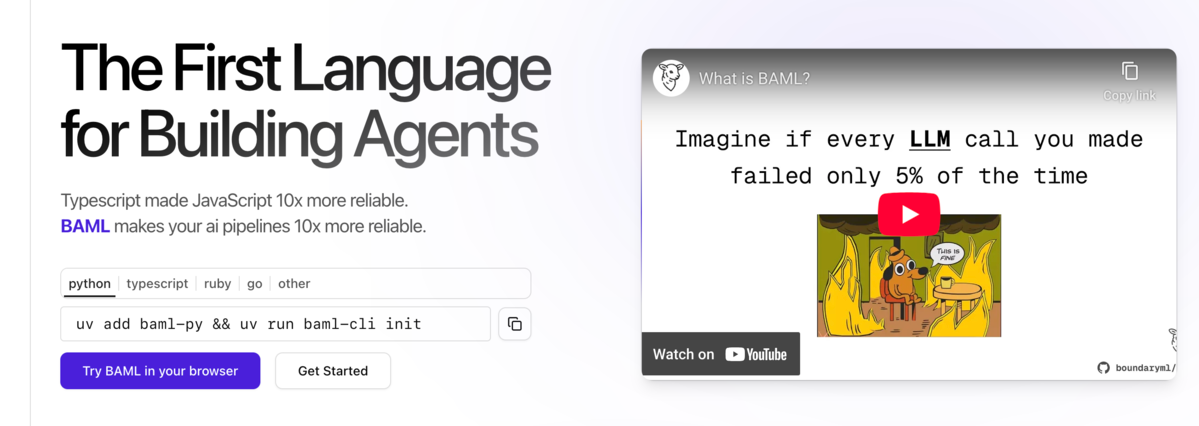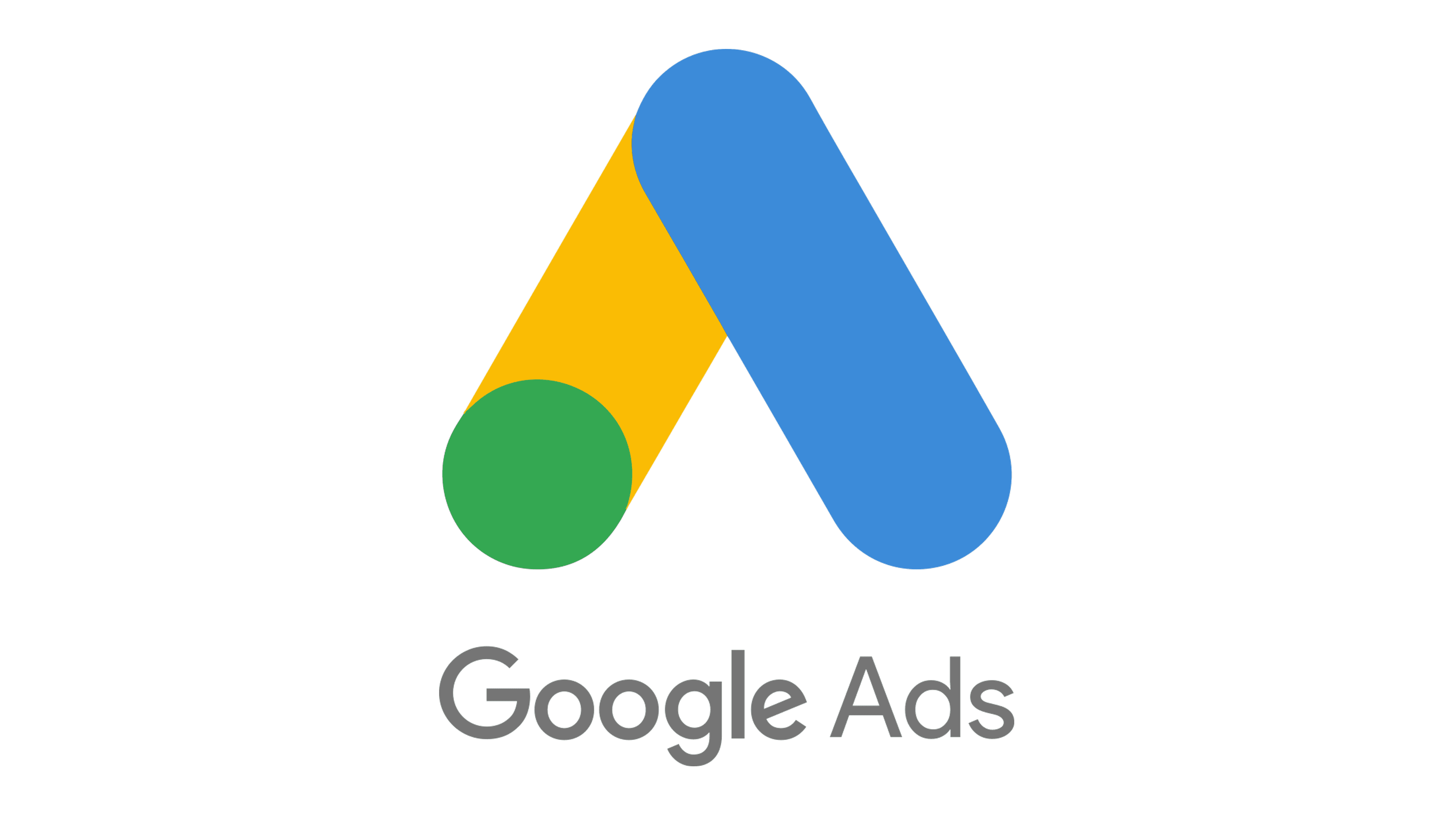
BAML

BAML (Boundary Markup Language) is an open-source domain-specific language that brings type safety and structure to AI development. It allows developers to define prompt functions, input and output schemas, and validation rules that automatically generate reliable code across languages like Python, TypeScript, Ruby, and Go. BAML ensures consistent, schema-validated responses from large language models, making AI applications more predictable, testable, and production-ready.
BAML Details
Ready to try BAML?
Check out BAML for pricing and explore how it can streamline your workflow.
Overview of BAML
What Is Boundary?
Boundary is an open-source framework designed to make AI applications type-safe, reliable, and production-ready. Its core technology, BAML (Boundary Markup Language), is a domain-specific language for defining and managing interactions with large language models.
With BAML, developers can create structured, predictable, and validated AI pipelines that generate consistent outputs across different programming languages. Boundary eliminates ambiguity in prompt design, improves reliability, and integrates easily with modern development workflows.
How To Use Boundary
Boundary can be installed through the command line using npm or pip, and configured within your existing codebase. Developers use BAML files to declare prompt functions, input schemas, and expected output structures. Once defined, the Boundary compiler automatically generates strongly typed code for Python, TypeScript, Ruby, or Go.
This approach ensures that every AI interaction is validated before runtime. BAML integrates seamlessly with testing frameworks and CI/CD pipelines, making it easy to maintain correctness as applications scale. Boundary also supports retries, fallbacks, and local testing to improve resilience in production environments.
Boundary Key Features
- Type-Safe AI Pipelines: Define inputs, outputs, and validations for every AI function.
- Cross-Language Code Generation: Automatically produce type-safe client code in Python, TypeScript, Ruby, or Go.
- Schema Enforcement: Ensure model outputs follow exact data structures without manual validation.
- Error Handling and Retries: Add built-in mechanisms for retries, timeouts, and fallback logic.
- Testing and CI/CD Integration: Validate LLM behavior during continuous integration and deployment.
- Prompt Functions: Declare reusable prompt templates with well-defined parameters.
- Developer Productivity: Simplify collaboration between engineers, data scientists, and product teams.
- Open Source and Extensible: Fully open-source with an active developer community and regular updates.
Boundary Use Cases
- AI Agent Development: Build reliable, schema-validated agents that perform multi-step reasoning and actions.
- Data Extraction and Structuring: Guarantee consistent, structured output from text, PDFs, or documents.
- Enterprise Automation: Enforce predictable model responses for compliance and auditability.
- API Integration: Create consistent interfaces between LLMs and back-end systems.
- Content Generation: Ensure formatted, validated outputs for reports, marketing materials, and summaries.
- Developer Tooling: Maintain strict data contracts between LLMs and your application codebase.
Boundary FAQ
Is Boundary free or paid?
Boundary and BAML are fully open-source and free to use. Enterprise support and advanced integrations may be available in the future.
What programming languages does Boundary support?
Boundary supports automatic code generation for Python, TypeScript, Ruby, and Go.
Can Boundary work with any LLM?
Yes. Boundary is model-agnostic and can connect to OpenAI, Anthropic, Gemini, or any API that supports text-based generation.
Does Boundary store user data?
No. Boundary does not store or process user data. It provides a framework that runs within your development environment.
Can I use Boundary in production systems?
Yes. Boundary is designed for reliability, validation, and deployment in production AI pipelines.
Why We Featured Boundary on Add AI Agents
At Add AI Agents, we highlight technologies that make AI more reliable, transparent, and developer-friendly. Boundary stands out for solving one of the most common challenges in AI development: unpredictable model outputs. By introducing BAML, a type-safe language for building structured AI workflows, Boundary gives developers the control and confidence needed to deploy AI systems that are robust, testable, and production-ready.
Ready to try BAML?
Check out BAML for pricing and explore how it can streamline your workflow.
Explore More AI Agents
Discover other AI agents and tools to enhance your workflow and productivity.
Browse All AgentsSimilar to BAML
View All Agents →
Antigravity
Antigravity is an agent driven development platform from Google that allows AI agents to write, test and validate software inside a complete desktop environment. It gives agents controlled access to the editor, terminal and browser so they can generate code, run applications and provide clear evidence of their work through artifacts like plans, diffs and recordings. By combining multi model intelligence with autonomous task execution, Antigravity acts like a dependable engineering partner that handles routine development, verifies results and supports higher level workflows. Its dual workspace system and multi agent coordination features help teams move faster, maintain cleaner code and build software with greater confidence and efficiency.

Devlo
Devlo is an AI powered engineering partner that helps software teams build, review, and maintain code with greater speed and consistency. It connects directly to your repositories and development workflow to automate issue resolution, generate pull requests, analyze code quality, and support day to day engineering tasks. By combining code understanding, workflow automation, and intelligent collaboration features, Devlo acts like an always available teammate who can handle routine work, enforce best practices, and improve overall productivity. With integrated project management, code analysis, and automated contributions, Devlo helps teams scale development output while keeping codebases clean, secure, and well organized.

Codemender
CodeMender is an AI powered security agent that automatically detects, analyzes, and repairs software vulnerabilities at scale. It combines advanced program analysis, multi agent reasoning, and automated validation to help developers secure their codebases with greater speed and accuracy. By integrating debugging tools, static and dynamic analysis, fuzzing, and intelligent patch generation, CodeMender can identify root causes, create high quality fixes, and rewrite unsafe code patterns before they become exploitable. With autonomous reasoning, safety checks, and human review workflows, CodeMender gives teams a reliable way to maintain secure code, eliminate entire classes of vulnerabilities, and strengthen the long term resilience of their software.
Trending AI Agents
View All Agents →
Google Ads Advisor
Google Ads Advisor and Analytics Advisor are AI powered assistants that help advertisers optimize campaigns, understand data, and make faster decisions across Google Ads and Google Analytics. They combine generative AI, real time insights, and account level learning to simplify how marketers manage performance. By integrating optimization tools, conversational analysis, and automated recommendations, the advisors make it easier to create high quality assets, discover growth opportunities, troubleshoot issues, and improve results. With personalized guidance, natural language interaction, and automated actions, these AI agents help teams streamline workflows, reduce manual effort, and scale more effective advertising strategies.

Agno
Agno is an AI-native workspace that allows teams and developers to build, deploy, and manage intelligent agents from a single platform. It combines model integration, workflow automation, and collaboration tools to streamline how AI systems are created and operated. With visual builders, API support, and enterprise-level management, Agno makes it easy to orchestrate multi-agent workflows, connect large language models, and scale production-ready AI solutions.

Pomelli
Pomelli by Google is an AI-powered reasoning and research workspace that combines structured intelligence, collaboration, and Google’s ecosystem into one adaptive environment. It enables users to explore ideas, analyze information, and build reasoning chains with full transparency. Integrated with Gemini and Google Search, Pomelli helps individuals and teams connect data, context, and insights across documents, Drive, and the web. Designed for researchers, strategists, and professionals, Pomelli transforms unstructured thinking into organized, explainable knowledge.
